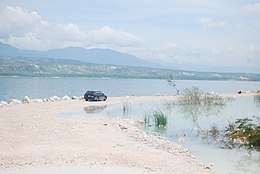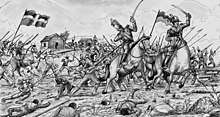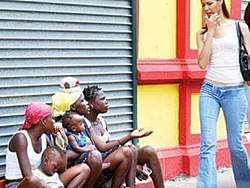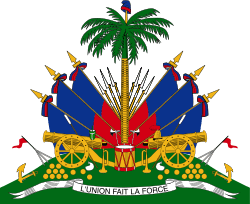Dominican Republic–Haiti relations
Dominican Republic–Haiti relations refers to the diplomatic relations between the Dominican Republic and the Republic of Haiti. Relations have long been complex due to the substantial ethnic and cultural differences between the two nations and their sharing the island of Hispaniola, part of the Greater Antilles archipelago in the Caribbean region. The living standards in the Dominican Republic are considerably higher than those in Haiti. The economy of the Dominican Republic is ten times larger than that of Haiti.[1] The migration of impoverished Haitians and deep-set cultural differences have contributed to a long-standing conflict.
 | |
Dominican Republic |
Haiti |
|---|---|

History
Pre-independence
Struggles began during colonial times and have developed into nearly constant conflict between the two governments.[2] The political division of the island of Hispaniola is due in part to the European struggle for control of the New World during the 17th century, when France and Spain began fighting for control of the island. They resolved their dispute in 1697 by splitting the island into two countries.[3] It was not until the 19th century that Haiti became independent from France on January 1, 1804. Spanish Haiti, the predecessor of the Dominican Republic, became independent from Spain on December 1, 1821, after more than 300 years of Spanish rule.
Ephemeral Independence and Unification of Hispaniola (1821–1844)
On November 9, 1821 the Spanish colony of Santo Domingo was overthrown by a group of rebels at the command of José Núñez de Cáceres, the colony's former administrator,[2][4] as they proclaimed independence from the Spanish crown on December 1, 1821.[5] The new nation was known as Republic of Spanish Haiti (Spanish: República del Haití Español), as Haiti had been the indigenous name of the island.[4]
_Portrait.jpg)
A group of Dominican military officers favored uniting the newly independent nation with Haiti, as they sought for political stability under Haitian president Jean-Pierre Boyer. The Dominicans were unaware that Boyer made a concession with the French, and agreed to pay France for the lost territory of Haiti. Boyer agreed to pay a sum of 150 million Francs (more than twice what France had charged the United States for the much larger Louisiana territory in 1803) thus the Haitians would essentially be forced into paying to maintain their freedom from the French.
During twenty-two years of Haitian occupation, the Haitians implemented what some Dominicans viewed as a brutal military regime. Use of the French language over Spanish was enforced, and the army closed Universidad Santo Tomás de Aquino. In addition, the Haitian army confiscated all church land and property and imposed mandatory military service. This difficult time for the Dominicans created cultural conflicts in language, race, religion and national tradition between the Dominicans and Haitians. Many Dominicans developed a resentment of Haitians, who they saw as oppressors.
In order to raise funds for the huge indemnity of 150 million francs that Haiti agreed to pay the former French colonists, and which was subsequently lowered to 60 million francs, Haiti imposed heavy taxes on the Dominicans. Since Haiti was unable to adequately provision its army, the occupying forces largely survived by commandeering or confiscating food and supplies at gunpoint. Attempts to redistribute land conflicted with the system of communal land tenure (terrenos comuneros), which had arisen with the ranching economy, and newly emancipated slaves resented being forced to grow cash crops under Boyer's Code Rural.[6] In rural areas, the Haitian administration was usually too inefficient to enforce its own laws. It was in the city of Santo Domingo that the effects of the occupation were most acutely felt, and it was there that the movement for independence originated.
Haiti's constitution also forbade non-citizens from owning land. However, it did protect citizens who were recognized for owning land from other's who may have tried and taken this land from them. According to their constitution, it was unlawful for one to deny property from A citizen who already owned it.[7]. Most emigrated to Cuba, Puerto Rico (these two being Spanish possessions at the time) or Gran Colombia, usually with the encouragement of Haitian officials, who acquired their lands. The Haitians, who associated the Roman Catholic Church with the French slave-masters who had exploited them before independence, confiscated all church property, deported all foreign clergy, and severed the ties of the remaining clergy to the Vatican. Santo Domingo's university, lacking both students and teachers had to close down, and thus the country suffered from a massive case of human capital flight.
Although the occupation effectively eliminated colonial slavery and instated a constitution modeled after the United States Constitution throughout the island, several resolutions and written dispositions were expressly aimed at converting average Dominicans into second-class citizens: restrictions of movement, prohibition to run for public office, night curfews, inability to travel in groups, banning of civilian organizations, and the indefinite closure of the state university (on the alleged grounds of its being a subversive organization) all led to the creation of movements advocating a forceful separation from Haiti with no compromises.
Dominican War of Independence (1844–1856)

On February 27, 1844 the Dominicans, led by Juan Pablo Duarte along with Francisco del Rosario Sánchez and Matías Ramón Mella, gained freedom from Haitian rule, thus giving birth to the Dominican Republic.
After ousting the Haitian occupying force from the country, Dominican nationalists had to fight against a series of attempted invasions from 1844 to 1856. Haitian soldiers would make incessant attacks to try to regain control of the territory, but these efforts were to no avail as the Dominicans would go on to win every battle henceforth. Since then, Dominican–Haitian relations have been unstable.[8]
Parsley Massacre (1937)
In October 1937, claiming that Haiti was harboring his former Dominican opponents, Rafael Trujillo ordered an attack on the border, slaughtering tens of thousands of Haitians as they tried to escape. The number of dead is still unknown, though it is now calculated between 20,000[9] and 30,000.[10]
Contemporary
Cultural and economic factors

In the mid-twentieth century, the economies of the two countries were comparable. Since that time, the Dominican economy has grown while the Haitian economy has diminished. The economic downturn in Haiti has been the result of factors such as internal power struggles, rapid population growth, environmental degradation, and trade embargoes. Today, Haiti is the poorest country in the Western Hemisphere. There is a lack of resources, and Haiti's population density exceeds its neighbor's by far. Despite the UN sending missions since the 1990s, in order to maintain peace, terrible conditions persist.[11]
One large contributor to cultural dissonance is the language barrier, as Spanish is the primary language spoken in the eastern part of Hispaniola (Dominican Republic) while French and Haitian Creole are spoken in the western part (Haiti). Race is another defining factor of Dominican–Haitian relations. The ethnic composition of the Dominican population is 73% mixed race,[12] 16% white, and 11% black;[13] while 95% of the Haitian population is black.[14]
The Dominican economy is also over 600% larger than the Haitian economy. The estimated annual per capita income is US$1,300 in Haiti and US$8,200 in Dominican Republic.[15] The divergence between the level of economic development between Haiti and the Dominican Republic makes their border the one with the highest contrast of all Western world borders and it is evident that the Dominican Republic has one of the highest illegal migration issues in the Americas.[16]
Haitian migration in the Dominican Republic
.jpg)
Some cross-border cooperation exists in areas such as health, business, and infrastructure. Many Haitians travel to the Dominican Republic to find seasonal or long-term work in order to send remittances to their families. Some of these Haitian workers, as well as Dominicans of Haitian descent have reported complaints of discrimination against them by the Dominican majority population. Other Haitians who would seek work, instead remain in Haiti, fearing discrimination on the other side of the border.[17]
Migration has been taking place since the 1920s, when Haitian laborers were actively encouraged to come work in the thriving Dominican sugar industry. With modernization from the 1960s on, fewer workers were required, and other Dominican industries and services started employing more Haitian workers, often an inexpensive, less regulated labor source with fewer legal protections. Many Haitian women find work in Dominican households, and Haitian men at Dominican construction sites, often leading to the move of an entire family.[17]
A large number of migrated Haitian workers have continued to live in the Dominican Republic over several generations. The two governments have been unable to agree upon a legal framework to address the nationality of these descendants, leaving around one million people of Haitian ancestry in the Dominican Republic effectively stateless, restricting their access to health care, education and employment opportunities.[17]
Though migration from Haiti to the Dominican Republic is economically beneficial to both countries, it is one of the leading contributors to tension between the two countries as well; illegal immigration from Haiti resonates high dissonance with the Dominican people. It has led to anti-Haitian feelings and mistrust of the Haitian people. Another problem with Haitian migration into Dominican Republic is that it blurs the line of citizenship. This factor of migration affects not only Dominican economy but its culture as well.[18]
Travel across the border is quite easy, with daily bus service from Santo Domingo to both Haiti's north and south coasts.[19] Much of the frontier remains very open, with regular crossings to markets on either side.[20] It is possible to drive much of the line and one unfenced north-south highway actually straddles the border.[21]
2010 Haitian earthquake
After the devastating earthquake of 12 January 2010, countless Haitians fled across the border to escape the quake's effects. The Dominican government was one of the first to send teams to help distribute food and medicine to the victims and made it easier for Haitians to acquire visas to receive treatment in Dominican hospitals. Supplies were transported to Haiti through the Dominican Republic, and many injured Haitians have been treated in Dominican hospitals.[22]
Haitian refugees were also taken in and supported by many Dominicans, though relations deteriorated as the refugees have remained in the Dominican Republic. This has led to reported concerns among some Dominicans that quake refugees contribute to rising crime, over-crowding, cholera and unemployment. More and more discrimination has been attributed to the massive numbers of Haitian refugees in the Dominican Republic. Over the past years tensions have risen, causing the International Organization for Migration to offer Haitians $50 each plus additional relocation assistance to return to Haiti. More than 1,500 have accepted that assistance and returned.[22]
Sports
The baseball federations of the Dominican Republic and Haiti have agreed to develop and promote baseball in Haiti (especially at the border), on the basis that sport is a developmental element to foster peace, as well as strengthening friendship and mutual respect between the two peoples. With the support of the Dominican ministry of Sports, the president of the Dominican Baseball Federation (FEDOBE) was thankful and quoted saying "it allows our federation to fulfill the dream of helping Haiti in baseball." He has pledged to put the Haitian Baseball Federation in relation to the international organizations. Coaches will be sent to Haiti for technical courses, referees and scorers by the Dominican Baseball Federation, while the Haitian Federation will support the logistics in the training and training programs.[23]
Footnotes
- "The Dominican Republic and Haiti: one island, two nations, lots of trouble".
- Lancer, Jalisco. "The Conflict Between Haiti and the Dominican Republic". AllEmpires. Archived from the original on 2015-12-11. Retrieved 2015-12-12.
- Wucker, Michele (1999). "Roosters". Why the Cocks Fight: Dominicans, Haitians, and the Struggle for Hispaniola (1st ed.). New York: Hill and Wang. p. 13. ISBN 978-0-8090-9713-5. LCCN 98-25785. OCLC 40200381. OL 365453M.
- Horváth, Zoltán (2014-06-21). Raeside, Rob (ed.). "Haiti: Historical Flags". Flags of the World. OCLC 39626054. Archived from the original on 2015-09-28.
- Gates, Henry Louis; Appiah, Anthony (1999). "Dominican-Haitian Relations". Africana: The Encyclopedia of the African and African American Experience. Retrieved 2007-12-24.
- Terrenos comuneros arose because of “scarce population, low value of the land, the absence of officials qualified to survey the lands, and the difficulty of dividing up the ranch in such a way that each would receive a share of the grasslands, forests, streams, palm groves, and small agricultural plots that, only when combined, made possible the exploitation of the ranch.” (Hoetink, The Dominican People: Notes for a Historical Sociology transl. Stephen Ault Pg. 83 (Johns Hopkins Press: Baltimore, 1982)
- Constitution of Haiti, 1964. Washington: Pan American Union, 1968. Print
- Moya, Pons Frank. 1977. Historia Colonial de Santo Domingo. 3rd ed. Santiago: Universidad Catolica Madre y Maestra.
- Dove, Rita (1997). "Writing 'Parsley'". In Pack, Robert; Parini, Jay (eds.). Introspections: American Poets on One of Their Own Poems. Bread Loaf Anthology (1st ed.). Middlebury, Vermont: Middlebury College Press. p. 78. ISBN 978-0-87451-773-6. LCCN 97-19542. OCLC 36842447.
On October 2, 1937, [Raphael] Trujillo had ordered 20,000 Haitian cane workers executed because they could not roll the ‘R’ in perejil, the Spanish word for parsley.
- Cambeira, Alan (1996). "The Era of Trujillo: 1930–1961". Quisqueya la Bella: The Dominican Republic in Historical and Cultural Perspective. Perspectives on Latin America and the Caribbean. Armonk, New York: M. E. Sharpe. p. 182. ISBN 978-0-7656-3305-7. LCCN 96-32355. OCLC 605229117.
During the 1937 massacre ... anyone ... found incapable of pronouncing correctly ... became a condemned individual. This holocaust is recorded as having a death toll reaching thirty thousand....
- Silver, Alexandra (2010-01-19). "Why Haiti and the Dominican Republic Are So Different". Time. Archived from the original on 2015-06-12.
- "DOMINICAN REPUBLIC". Encyclopedia of the Nations.
- Field Listing: Ethnic Groups § Dominican Republic. The World Factbook. Central Intelligence Agency. 2015. ISSN 1553-8133. OCLC 644186015. Archived from the original on 2015-09-19.
- Field Listing: Ethnic Groups § Haiti. The World Factbook. Central Intelligence Agency. 2015. ISSN 1553-8133. OCLC 644186015. Archived from the original on 2015-09-19.
- Bello, Marisol (January 21, 2010). "Hispaniola comparison". USA Today. Retrieved 2016-10-09.
- IMF - PIB per cápita (PPA) República Dominicana / Haití
- Schaaf, Bryan (2009-05-21). "Haiti and the Dominican Republic: Same Island, Different Worlds". Haiti Innovation. Washington, DC. Archived from the original on 2015-01-04.
- Taylor, Erin B. (2013-12-25) [1st pub. 2013-10-25]. "Generations of Haitian Descendents Made Stateless in the Dominican Republic". The Huffington Post. Archived from the original on 2015-10-31.
- Capital Coach Line bus from Port-au-Prince to Santo Domingo
- In Photos: Life at the Largest Border Crossing Between Haiti and the Dominican Republic
- Driving the Seam of Hispaniola
- Childress, Sarah (August 31, 2011). "DR to Haitians: get lost". Retrieved April 22, 2013.
- Press, ed. (10 February 2016). "Acuerdan fomentar el béisbol en Haití". Metro. Retrieved 25 May 2017. (in Spanish)

